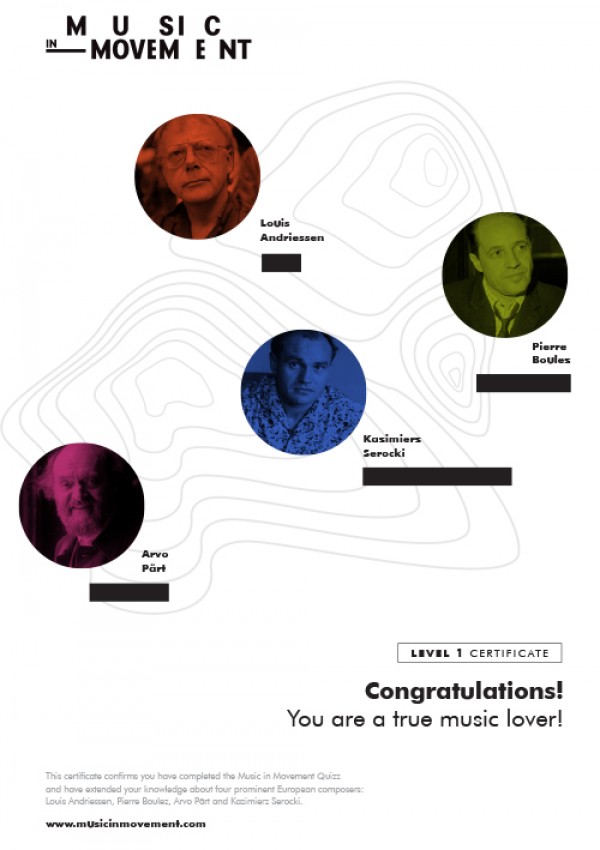MiM quiz – Expert level / Education
Remember, this quiz is not about testing your knowledge about contemporary music. It's all about getting to know the four composers - their music, techniques, but also inspirations and private stories. We invite you to take on this challenge - discover the universe of four personalities and dive in into their music.
In which example is the sound of instruments transformed electronically?
Choose one or more:
Pierre Boulez – …explosante-fixe… for MIDI flute, two flutes, ensemble and electronics (1991–93).
Louis Andriessen – De Tijd for choir and orchestra (1980–81). Louis Andriessen sometimes used electronics, but the sophisticated colours and effects in the piece are achieved without electronics.
Kazimierz Serocki – Pianophonie for piano with electronic transformation of sound and orchestra (1979).
Arvo Pärt – Miserere (1989–92). Arvo Pärt did not use electronics, the reverberation is, of course, entirely natural.
Composers and trends of music of the recent and distant past had a considerable influence on all four composers. Link a source of inspiration to a composer.
The affinity between Stravinsky’s and Louis Andriessen’s music is evidenced not only by the Dutch composer’s works but also by a book devoted to the Russian’s oeuvre which Louis Andriessen co-authored (The Apollonian Clockwork).
The impact of Bartók’s music can easily be discerned in Kazimierz Serocki’s oeuvre of the first half of the 1950s, for example, in his Sonata for piano.
To a large extent the style and techniques Arvo Pärt developed in the late 1960s and early 1970s were a result of his studies of Renaissance and late medieval polyphony, and Gregorian chant.
The avant-garde of the 1950s, including Pierre Boulez, considered the music of Anton Webern to be its predecessor and model to be developed further.
With whom did the four composers study?
Arvo Pärt studied composition in Tallinn with e.g. Veljo Tormis, a composer known primarily for his choral compositions.
The eminent Italian composer Luciano Berio was young Louis Andriessen’s composition professor in 1962–1964.
In the same period, also in Paris, Olivier Messiaen conducted his famous analysis class – his broad horizons, unconventional interests and openness attracted many composers, including Pierre Boulez, who several years later became leading figures of the European avant-garde.
Nadia Boulanger (1887–1979) was a teacher of many outstanding composers, including Kazimierz Serocki, who in 1947–1948 explored the secrets of composing under her guidance thanks to a scholarship he had been granted.
Figures (from outside the world of music) important to the four composers:
Match the figure to a composer.
Kazimierz Serocki wrote music to Jerzy Hoffman’s Oscar-nominated film The Deluge.
In 1976, at the Wagner festival in Bayreuth, Pierre Boulez conducted Der Ring des Nibelungen in a production directed by Patrice Chéreau – to this day considered to be one of the best stagings of Wagner’s cycle.
The most popular and exemplary recordings of Arvo Pärt’s music have been issued by the ECM label headed by Manfred Eicher.
Peter Greenaway worked with Louis Andriessen on several musical-film and musical-stage projects (M is for Man, Music, Mozart; Rosa, Writing to Vermeer).
Well done!
We hope you enjoyed the experience!
You can now share & save your MiM certificate!

